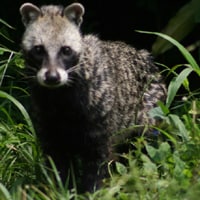Bringing civets, binturongs, genets and other Viverridae into the United States
Bringing a civet, binturong, genet (or any animal belonging to the family Viverridae) into the United States is prohibited.

Bringing a civet, binturong, genet (or any animal belonging to the family Viverridae) into the United States is prohibited.
Species belonging to the family Viverridae, including civets, binturongs, genets, linsangs, etc., may not be imported into the U.S. They are prohibited because they may carry the SARS virus.
About civets: A civet is a meat-eating mammal. In general, a civet has a somewhat cat-like appearance with a small head, long body, and long tail, although a civet is not in fact a cat. Its muzzle is long and often pointed, rather like that of an otter or a mongoose. Excluding its tail, a civet ranges from about 17 inches to 28 inches long, and weighs between three to 10 pounds. There are several species of civets; they are native to most of Africa, the Spanish peninsula, southern China, and Southeast Asia.
For more information about the prohibition against importing civets, please read Questions and Answers on the Embargo of Civets on the SARS site.
Civet oil is often requested for import into the United States for use in the perfume industry. Please see Bringing Animal Products into the United States for more information.
Civets Imported for Permitted Purposes
If you have questions about importing civets for scientific, exhibition, or educational purposes, contact CDCanimalimports@cdc.gov.